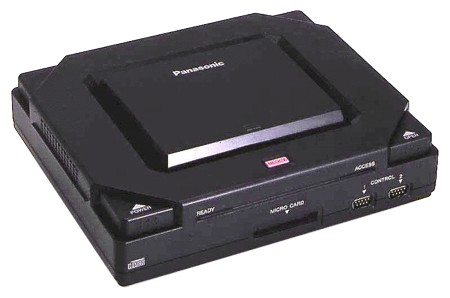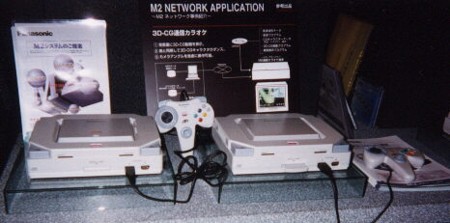The console that was never meant to be…
The aborted successor to the 3DO M2, initially started life as an addon to the 3DO, then the Sega 32X happened and the 3DO company went ‘fuck that’ and spun the M2 off to its own console. A good thing really as the 2x speed CD-ROM drive of the 3DO would have been a huge bottleneck.

Design wise it looks very much a console of the 90s, and wouldn’t look out of place next to the PlayStation or the Saturn
The M2 contains two PowerPC 602 CPUs, which are linked to a Bulldog ASIC which serves as the central hub and the main chipset that is responsible for the graphics rendering. Contrary to popular belief these processors are not 64bit, they are 32bit RISC PowerPC that are similar to other processors in that range like the 601 or 603. The 602 is intact an embedded version of the 603 with a few amendments to reduce the cost, The L1 cache was reduced and the prediction unit was scaled down. The only 64bit PowerPC processor IBM manufactured was the 620 and the POWER range of CPU’s.
The 602 are widely believed to be used in the T&L/Geometry stage of graphics rendering, like the role of the GTE on the original PlayStation or the DSP’s on the Model 2 / System 22 arcade boards. The Bulldog ASIC would then accelerate the 3D processing and would apply texture wrapping effects. This is according to the Feb 97 issue of Next Generation magazine, where one 602 is used for the game code and the other is used for geometry. Each 602 is capable of 70MIPS each, 140 combined. Compared to the PlayStation who CPU is capable to 30MIPS, and 66MIPS for the GTE, 96 in total. The MDEC figure of 80MIPS is not included as that is a dedicated processor which cannot be reprogrammed.
However – The June 97 issue makes reference to a triangle engine in the BDA processor which was like the PlayStation’s GTE, so it seems that would have been generating the polygons and upgrading the BDA to a full dedicated GPU rather than an accelerator
But by 1997 the 602 would’ve obsolete, as Apple would be using the PowerPC 604 and would launch the PowerMac G3 models which used the PowerPC 750 processors which were a lot more capable.
The BDA is also capable of MPEG1 decoding (not MPEG2 that was used for DVD or DVB digital TV) which would allow for better quality full motion video compared to the PlayStation or the Sega Saturn. MP1 (MPEG Audio Layer could also be decoded using this black which would allow for compressed audio similar to CD quality sound at a fraction of the size (But not as much as MP2/MP3)
Early magazines seem to make reference to an ARM co-processor which would have been used for 3DO backwards compatibility. Possible this was dropped to reduce the cost for the hardware.
Konami M2
This was the only major deployment of the M2 hardware and was designed to be used in the arcade and supplemented Konami’s existing arcade line-up, mainly due to its PowerPC processors which Konami also used in their other machines. Unfortunately Konami made a stupid decision to use a CD-ROM drive to store the game data which resulted in long load times and excessive failure rates, since the game is constantly loading from the CD-ROM drive during the demo and attract mode.
Not sure why Konami didn’t just use a hard drive which would have been much more reliable. Some of Midway’s later games used a hard drive and the M2 hardware could have been adapted easily.
Only a few games were released before Konami abandoned it
Screenshots will be provided here one MAME emulates the thing.
Graphics wise the M2 seems on par with Sega the Model 2 or the Namco System 22, which perform similar to the polygon count. As the M2 is a later design it benefits from increased efficiently and additional 3D functions.
Panasonic FZ-21S
What would have been the console version of the hardware, this unit comes with two controller ports, less that the Nintendo 64 but still more than the 3DO. A single memory card slot is used for storing game saves in a similar fashion to the PlayStation. At the back there is a read PCMCIA slot for future expansion devices such as a modem or a network card

Panasonic FZ-35S
The professional version of the M2 hardware, this sort of resembles a cross between a compact PC and a DVD player, with a front tray loading disc drive. At the rear there is a multitude of ports for various connections. Dual RS232 serial ports, PS/2 keyboard and mouse ports, VGA/S-Video out along with composite video and stereo audio out.
This was marketed and sold as an interactive media player and was used for commercial and business applications, like in showrooms to advertise products. In a way its similar in function as the commercial versions of the Philips CDi.
3DO M3/MX
Console that would have succeeded the M2, MX was rumoured to be only twice as powerful as the M2, and was meant to be a slight upgrade. A more ambitions version of MX was planned to have embedded DRAM in its chipset which would have boosted the console filtrate significantly, like Sony did with the PS2.
Extracts
The new hardware picture wouldn’t be complete without including 3DO, so we’ll now shift gears over to the MX. Like the M2 before it, 3DO claim the MX will be its generation’s top gun. Our Q-spies report that the M2’s successor is already past the design document state and is actually living breathing hardware. At the moment, the MX chipset is physically huge (it can barely fit on a good-sized table) but once 3DO gets all the bugs out, they’ll work on reducing the size (common practice in the hardware biz). By all accounts, the MX is a screamer, with close to 5 million polygons boogying around the screen at once. Not only can the MX produce N64/M2-type graphic effects like Trilinear Mip Mapping and Edge Antialiasing, but it can handle such esoteric real-time graphic functions like Anisotropic filtering, Phong-Lighting and Surface Antialiasing. The secret to the MX’s ultra-high performance lies in its radical hardware architecture. Unlike all others before it, the MX’s RAM is incorporated into the same chip as the CPU and graphic processor. Set up in this manner, game information can now run at the same clock speed as the CPU (a 110 MHz Power PC 604) or the graphic processor (which is basically a 128-bit ASIC). The MX is less than a year away from completion, but 3DO has already shown the technology to a large Japanese software company who has shown interest in developing for the machine and perhaps even buying the hardware rights outright. The mystery software company is led by a certain Mr. Hironobu Sakaguchi, but you didn’t hear it from me.
Unknown, Possibly from EDGE magazine
Use of the PowerPC 604 is interesting, the Konami Cobra also used the 604
As for MX (see IG’s Fusion issue 10), the current concept being tossed around is the idea of actually including the video RAM frame buffer within the actual MX chipset rather than externally — as transferring data from separate RAM chips to the math processors is one of the most vital time delays in any computer or game console, having the RAM bundled with the fast MX chipset would mean incredible speedups in processing. Developers claim that such an MX chipset could deliver — believe it or not — 15-20 million polygon per second performance. The drawback? The failure rate of such combined chips could be prohibitively high — between the RAM and the high-intensity math processor, the chips could fail in production at a rate of 20% or greater depending on how much RAM was included on a chip. Additionally, the heat generated by such a configuration would mandate special cooling measures. Regardless, the premise is food for thought and some additional RAM may well wind up in the final MX design.
Intelligent Gamer Fusion Magazine, May 1996
MX, the console after M2 could have featured eDRAM like the PS2 and Xbox 360
Also mentioned in the article is how two new chipsets are supposedly under development. One is an enhanced M2 codenamed MX and is described as ‘M2 on steroids’. BTW it is mentioned that the M is really most likely a common moniker used for version 2 type projects meaning it stands for mark, thus ‘Mark 2’. And in MX the X is obviously a variable. MX so far ‘offers twice the performance of the M2 chipset…currently intended for PC and arcade use…’. Finally the totally newer chipset is codenamed S42 – S being just another letter like M and 42 being the one calculated as the meaning of life by the computer Deep Thought in the Hithchiker’s Guide to the Galaxy. S42 being post 64bit era forecasting that probably is the equivalent of the M2 when the Opera was being made.
Intelligent Gamer Fusion Magazine, May 1996
M2, then MX/M3, then S42
This time Matsushita had a very viable solution for Nintendo, the MX console. What was the MX? Well, details are sketchy, but it was supposed to be the successor of the M2. Sporting two Power PC CPUs that each alone had several times the power of the M2, and pushing a lot more polygons, this system was designed for speed. Nintendo actually entered into negotiations with Matsushita about using the technology. However, Nintendo was still a fan of MIPS CPUs and wanted to use them. The architectures where not compatible, and the MX went down just like its younger brother. Or did it? Perhaps, part of it lives in the Dolphin. Rumors persist that some of the foundations of the Dolphin are based of early MX designs. Only Nintendo knows for sure.
Vortexgaming.com
Nintendo were also interested in MX technology for their next console, given the bottlenecks and drawbacks of the Nintendo 64. Seems like they experimented with different PowerPC processors, wonder how it would have fared with two PowerPC 7400 (G4) with their AntiVec units?
Articles of interest
Next Generation: Issue June 95
https://i.imgur.com/X7ZyUWF.jpeg
https://i.imgur.com/cjulC5v.jpeg
https://i.imgur.com/HddEBSr.jpeg
https://i.imgur.com/zVjWrgR.jpeg
https://i.imgur.com/2eLwcfQ.jpeg
Unknown issue:
https://i.imgur.com/Ks3rxaw.jpeg
Next Generation: Issue July 1995
https://i.imgur.com/UM0cm8x.jpeg
https://i.imgur.com/5X9i71P.jpeg
https://i.imgur.com/gW7rnSK.jpeg
https://i.imgur.com/FwasYLn.jpeg
https://i.imgur.com/n5pGl7c.jpeg
https://i.imgur.com/LvfjGiW.jpeg
Next Generation: December 95
https://i.imgur.com/fSsVuZA.jpeg
https://i.imgur.com/oz9gi8J.jpeg
https://i.imgur.com/98MAb9d.jpeg
https://i.imgur.com/OSgacNU.jpeg
https://i.imgur.com/HOQfw2D.jpeg
https://i.imgur.com/w4XWQGx.jpeg
Edge Magazine: July 1996
https://i.imgur.com/6x4QP5z.jpeg
https://i.imgur.com/PQKBPld.jpeg
https://i.imgur.com/e5OWH3n.jpeg
https://i.imgur.com/w4XWQGx.jpeg
https://i.imgur.com/OLnEj22.jpeg
Next Generation: October 1996
https://i.imgur.com/E6w3JRQ.jpeg
https://i.imgur.com/vSWS1lt.jpeg
https://i.imgur.com/lw8Qx69.jpeg
https://i.imgur.com/wtjhxga.jpeg
Next Generation: Issue Feb 97
https://i.imgur.com/pWwS56h.jpeg
https://i.imgur.com/n9YpE5r.jpeg
Next Generation: Issue June 97
https://i.imgur.com/ScCB1F4.jpeg
https://i.imgur.com/fuTtbkO.jpeg
https://i.imgur.com/ZmrZ67F.jpeg
Next Generation: Issue September 97
M2 Cancelled 😦
https://i.imgur.com/DkDqa9R.jpeg
https://i.imgur.com/amrngkE.jpeg
Edge: January 1998
https://i.imgur.com/Z6qW4LN.jpg
External Links
VideoGameEsoteria is a good resource for all M2 content with footage from Konami and development software. Linked is the full playlist of M2 content.
M2 Information, In Japanese – Archive
Everything2 3DO – Archive
Archive3DO – Lots of archived and recovered M2 material
Microsoft M2/MX/Early Xbox
Microsoft reportedly working on game console
Microsoft were shopping for graphics solution for their upcoming Xbox console and the later MX chipset was being considered, Gigapixel were also being considered before going with Nvidia